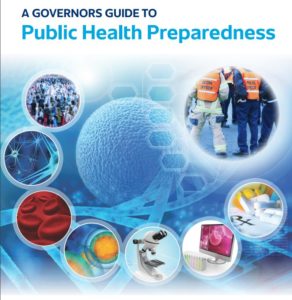Executive Summary
Beginning on their first day in office, governors must prepare for emergencies of all types. Along with providing for the public’s safety, governors must also think about protecting the public’s health. Although the types of hazards that affect states and territories vary widely, almost all carry a public health consequence that must be specifically and intentionally addressed.
This guide serves as a primer on public health emergency preparedness for governors and their staff. It details current strategies, available resources and existing partnerships to aid Governors in continuing to strengthen their state or territory’s cooperative network for emergency response and provide their states with a safe and healthy future.
While infectious diseases like COVID-19, Mpox, Zika and Ebola present an obvious danger to public health, it is important to recognize that natural and human-made disasters create similar threats. Earthquakes, heat waves, flooding and terrorist attacks can all cause cascading interruptions in the availability of medication, shelter, sanitation, and access to medical care, thereby eroding community health. Consider the power outages created by wildfire disasters: while the outages may not have posed a direct risk to the health of the general public, they endangered those dependent on dialysis facilities and electrically powered medical devices. Major disasters can also contribute to short- and long-term mental and behavioral health risks, including depression, anxiety disorders and even suicide.
As these risks continue to increase, it is vital for Governors, homeland security advisors, emergency managers and public health officials to work together to integrate public health considerations into all aspects of their comprehensive approach to preparedness, response, and recovery.
Public health emergency preparedness is a technical discipline that often requires subject matter expertise for proper interpretation and execution. This roadmap gives nonmedical practitioners, such as governors and homeland security advisors, the foundational knowledge they need to engage with their public health counterparts so that they can develop meaningful partnerships, cooperative plans, and complementary policies.
This is an update to an earlier guide published in January, 2020.













